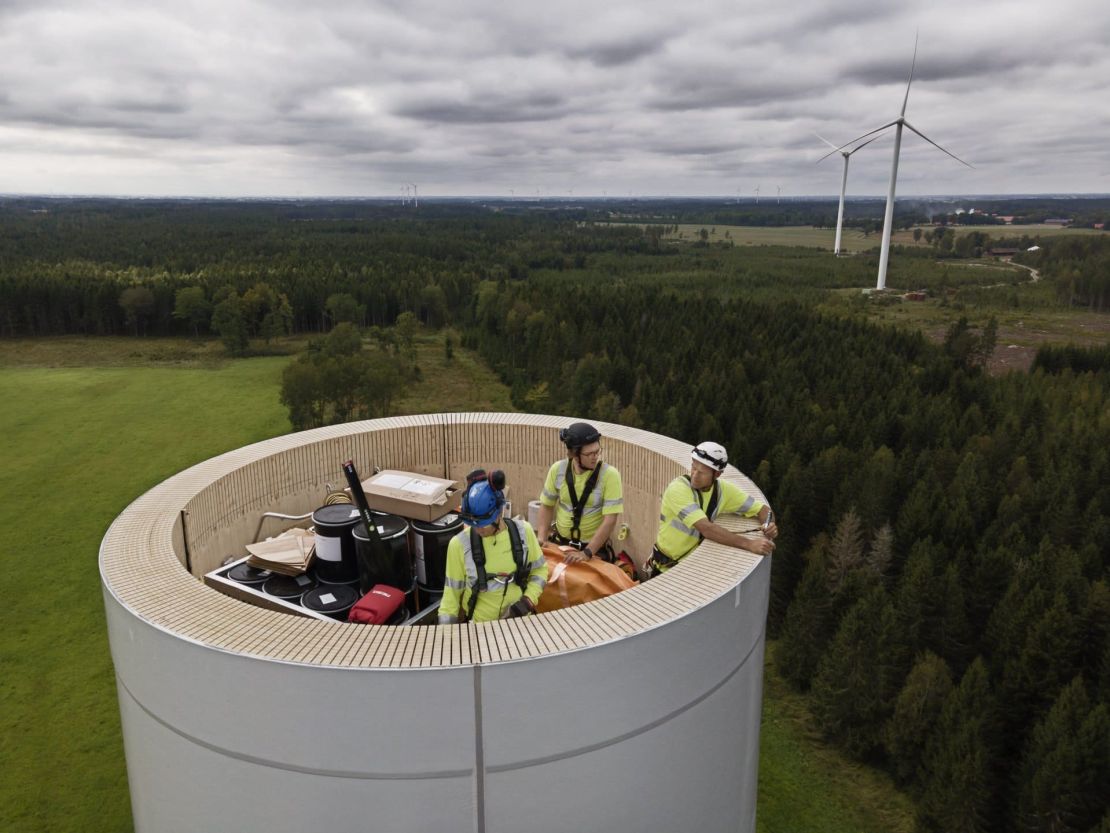Editor’s Be aware: Name to Earth is a CNN editorial sequence dedicated to reporting on the environmental challenges dealing with our planet, along with the options. Rolex’s Perpetual Planet initiative has partnered with CNN to drive consciousness and training round key sustainability points and to encourage constructive motion.
CNN
—
Wind energy is significant to assist decarbonize the power trade. Nonetheless, whereas the electrical energy it generates has a small carbon footprint, the towers of standard wind generators are predominately made utilizing carbon-intensive supplies like metal. Swedish firm Modvion believes it has discovered a greener different — constructing turbine towers from wooden.
Nearly two tons of carbon dioxide are emitted for each ton of metal manufactured, and a contemporary onshore wind turbine “comprises round 120 metric tons of metal per megawatt of capability,” based on trade group WindEurope.
As an alternative of metal, Modvion makes use of laminated veneer lumber (LVL), produced from a number of layers of wooden caught along with adhesives. The LVL boards are manufactured into modules that are then transported and assembled into cylinders on website, earlier than being stacked on prime of one another, and joined with glue, to create a tower.
The corporate says it makes use of Scandinavian spruce wooden sourced from reforestation-certified sustainably managed northern forests in Sweden, and a typical tower makes use of between 300 to 1,200 cubic meters of wooden.

In accordance with Otto Lundman, co-founder and CEO of Modvion, utilizing picket towers reduces the lifecycle emissions of a wind turbine by over 25%, and by 90% should you solely evaluate the tower element of the turbine.
He provides that should you bear in mind the carbon dioxide absorbed by timber after they develop, the picket towers might be thought-about to retailer extra carbon that they emit. Nonetheless, some researchers dispute the concept constructing with wooden might be carbon impartial.
Modvion was based in 2016 by Lundman and architect David Olivegren, and 4 years later, with some funding from the Swedish Vitality Company, Modvion launched a prototype 30-meter tower on Björkö island, Sweden.
In 2023 the corporate put in its first industrial two-megawatt unit, a 105-meter-high (345 toes) picket turbine tower, known as Wind of Change, outdoors Skara, Sweden, for electrical utility firm Varberg Energi.
Apart from the environmental advantages, Lundman says laminated wooden has a number of logistical benefits. Wooden has a better power per weight than metal, and tall metal towers want further enforcement to carry their personal weight, not like picket ones. Meaning Modvion’s towers might be 30% lighter than a metal one, based on Lundman.
The towers’ modular design means they might be transported utilizing commonplace vehicles and roads, and as soon as the turbine is decommissioned, the wooden might be taken right down to be reused within the development trade as high-strength beams. The corporate says that over time, its towers are cheaper than metal ones, with taller towers giving greater financial savings.
“We hope and we’re seeing that we’re altering the angle on wooden as a cloth,” says Lundman. “That is actually nature’s carbon fiber, inexperienced metal that grows. It must be used much more.”
Dr. Abbas Kazemi Amiri, from the Wind Vitality and Management Centre on the College of Strathclyde, Glasgow within the UK, who’s unrelated to Modvion, says that whereas wooden has important potential, there are many unknowns about laminated wooden that would trigger issues.
“Not like metal, concrete, and artificial composites, which have undergone intensive mechanical and fatigue testing over a long time, this kind of novel laminated wooden lacks such complete testing,” says Amiri. “Conducting thorough checks sooner or later can be essential for the widespread commercialization of picket towers.”
He provides: “The mechanical properties of wooden can change with environmental situations, doubtlessly impacting the behaviour of picket towers … Additional analysis is required to deal with these uncertainties.”

Lack of present analysis and pointers into the usage of wooden for big constructions like wind generators had been Modvion’s greatest challenges, says Lundman.
“We’re designing our towers that correspond to the requirements in each wind energy and wooden development,” he explains. “However in wind energy requirements, wooden will not be actually thought-about for the towers, it’s principally metal and concrete. And within the wooden development requirements, they don’t actually get into the form of dynamically loaded construction {that a} wind energy machine is.
“Therefore, we wanted to bridge this hole, and we’ve accomplished a whole lot of testing of all the assorted components in our towers to show by displaying in actuality how these elements work [over the] lifetime of a turbine.”
Modvion towers are coated with a thick, waterproof paint, and like metal towers, they’ve a lifetime of 25 to 30 years, based on the corporate.
At present, Modvion is within the design part for its first six-megawatt turbine, which can be put in subsequent yr. By 2027, it goals to start out industrial manufacturing of the turbine in a brand new manufacturing facility.
Whereas the corporate is just specializing in the tower element, Lundman says turbine blades — that are historically manufactured from fiberglass sure along with epoxy resin, an extremely robust materials that’s troublesome and costly to recycle — may be made with wooden.
Different start-ups have begun to sort out this difficulty, together with German firm Voodin Blades, which makes turbine blades from LVL, which it says are fully biodegradable.
“Wind energy is without doubt one of the most tasty renewable power sources that we have now,” says Lundman. “By enabling taller, extra environment friendly towers each from an emissions and price perspective, we make them much more enticing.”











